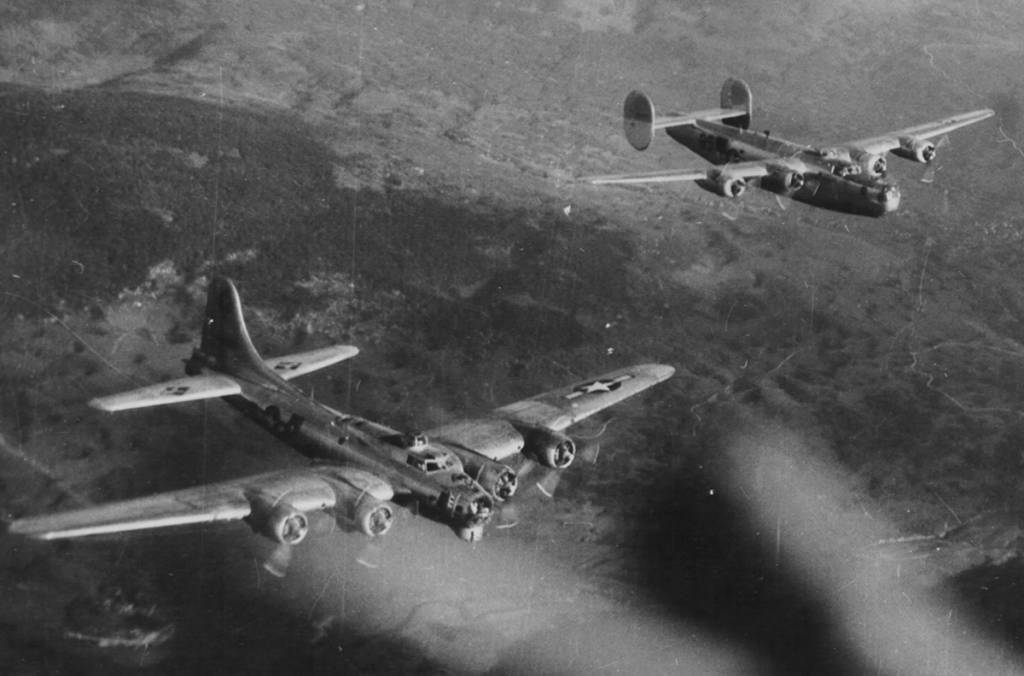B-17 Bomber Flying Fortress – The Queen Of The Skies B-17 Vs. B-24
 English
English Deutsch
Deutsch
The majority of three thousand officers and enlisted men in Eight Air Force heavy bomber crews tallied between 28 May and 5 June 1944 said their aircraft – be they B-17s or B-24s – were the best for the job. When separated into B-17 and B-24 crews, 92 percent of the surveyed B-17 crews said they had the best type of machine, compared with 76 percent of the polled B-24 crews who said they had the best type of aircraft. As the survey summary noted: “The proportion who are ‘sold’ on their own plane is… greater among B-17 crew members.”

The survey presented other conclusions about Eight Air Force crews and their two types of heavy bombers: “In both B-17 and B-24 crew, men who are convinced their type of ship is best are more likely than other men to express satisfaction with their jobs. In B-24 crews, the bombardiers, navigators and co-pilots appear somewhat less likely than other crew members to feel they have the best of airplane. In B-17 crews, men in the different crew positions do not differ appreciably in the appraisal they give their ship “The study emphasized that “B-17 and B-24 crews do not differ in their belief in the importance of the job they are doing”, and that the two types of crews did not differ “in their expressed willingness to take on another series of missions nor in the proportions who say they would sign up for combat flying if they were starting all over again.”
Poll
Interestingly, in both B-17s and B-24s, co-pilots were the least likely to answer “yes” to the question, “Do you think you have the best type of airplane for the particular job which you have to do?” The 1944 survey drew no inference from this statistic, although a latter-day assessment might conclude that of all crew positions, only co-pilots have a built-in job dissatisfaction linked with their ambitions to become pilots. In the survey, the total sample of 3,000 crew men might yield only 100 to 200 in any one crew position for each type of bomber and the surveyors cautioned that this small sample “must be regarded as suggestive, rather than conclusive evidence of a real difference between crew positions existing in the total Eight air Force heavy bomber crews from which this cross-section sample was drawn.” By crew position, those who said: “yes” that theirs was the best type of airplane for the particular job they had to do produced the following numbers for the survey.
| Co-Pilots | Engineer | ||
|---|---|---|---|
| B-17 Crews | 88% | B-17 Crews | 93% |
| B-24 Crews | 58% | B-24 Crews | 91% |
| Navigators | Pilots, Radio Operators and Gunners | ||
|---|---|---|---|
| B-17 Crews | 93% | B-17 Crews | 79% |
| B-24 Crews | 63% | B-24 Crews | 92% |
| Bombardiers | Men in all crew positions combined | ||
|---|---|---|---|
| B-17 Crews | 93% | B-17 Crews | 92% |
| B-24 Crews | 65% | B-24 Crews | 76% |
Pilots, radio operators and gunners were tallied together because, the survey said, they showed “no appreciable difference” in their responses to the question.
Engineers for both types of bombers posted high satisfaction rates. Again, while the 1944 survey did not endeavor to explain this phenomenon, an after-the-fact observation might conclude that engineers on both types of heavy bomber received intense technical training on their particular aircraft and were intimately familiar with its systems and functions, possibly generating a high degree of confidence as a result of this knowledge and training.
The markedly higher satisfaction rates expressed by B-17 navigators and bombardiers than their B-24 counterparts may be attributed to the generally roomier nose section in a B-17. For these crew members, working conditions were better in a Flying Fortress. an extreme example of this was the grafting of a complete B-17G nose to a B-24J in the US for evaluation. While the hybrid bomber had poor flying characteristics, an AAF evaluation commented favorably and probably wryly, on the improved working area for the navigator and bombardier in this particular B-24!
Interestingly, absent from the 1944 survey report was any suggestion that the surveyed crewmen thought either the B-17 or the B-24 was more combat-survivable than other type of bomber, although one B-24 crewman commented on cramped quarters in the nose impeding fast bailouts.
Statistics compiled by the AAF in 1944 showed a rising trend in the average number of sorties per month per crew assigned to operational groups in the Eight Air Force. In November 1943 (the first month of survey), the average number of sorties for the month for B-24 crews was about two; for B-17 crews the average was about 2.8 B-17 crew sortie rates remained higher than B-24 rates until April 1944, when Eight Air Force B-24 crews posted an average of seven sorties per month per crew, compared with the B-17 crews’ average somewhere near 6.6 sorties a month. By May 1944, the last month of the chart, B-24 crew sorties averaged around 8.3, while B-17 crew sorties averaged about 7.4, within the limitations of the graph. Clearly, the number of sorties was increasing for both types of bomber crew.
The debate over merits of B-17s versus B-24s began when the two airplanes were new and will linger long after publication of this volume. there is evidence to suggest the USAAF even fueled the controversy while trying to instill pride in each type of bomber crew. Some editions of the pilot’s manual for the B-17, when explaining go-around procedures for landings, accompany the text with a drawing of a crashed B-24 on the runway blocking the B-17’s intended landing. Similarly, the same section in some B-24 pilot manuals shows a crashed B-17 as the cause of the B-24’s go-around!





